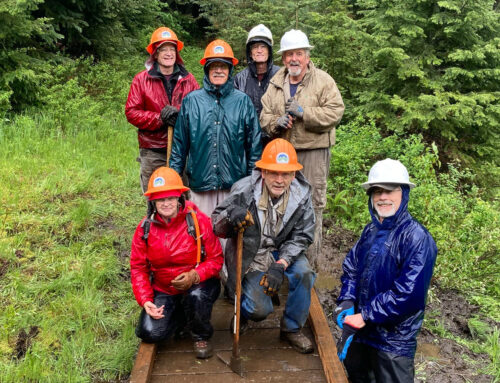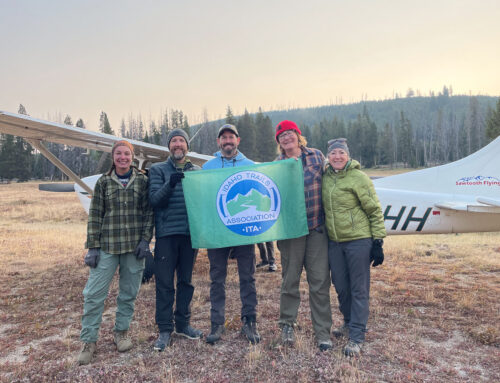
Alexis Bennett is an Idaho native who enjoys big hikes and trails with her son and dog. Her street credit includes 20 years of running and weight training experience, including as a collegiate track athlete, finishing the Boise Trail Challenge on foot in 2023, and holding the women’s single-day Boise Grand Slam record.
 Trail season is right around the corner. And if you’re like almost every trail lover – me included – you’re already thinking about the trips you want to take, the peaks you want to summit, and the alpine lakes you want to lunch at this season.
Trail season is right around the corner. And if you’re like almost every trail lover – me included – you’re already thinking about the trips you want to take, the peaks you want to summit, and the alpine lakes you want to lunch at this season.
But, dreaming only takes you so far. Your feet must take you the rest of the way.
While I like to stay pretty active all year long, there’s no doubt I’m less disciplined and more relaxed during the winter months. I try to keep a base level of fitness all year because 1) I enjoy skiing and other snow sports, and 2) I’ve found I’m less likely to get injured when I ramp up my activity in the spring.
Knowing that I’ll probably be itching to hit the trails starting in April, I’ll build my fitness starting as early as February in three key areas. To prepare for long hikes and steep climbs, I focus on basic endurance, climbing strength, and overall body resilience.
Spending Time on Your Feet
To go long distances, your body must be able to go long distances.
If I have a beautiful or difficult 14-mile hike or trail run in my sites, I want to make sure I know I can make the distance. It’s not only more enjoyable because I can check out the sites without worrying about muscle soreness and blisters, but it’s also safer for the same reasons. Even for shorter distances, I like to be comfortable, so I spend time off the trail, either walking, road running, or riding a bike building my endurance.
Pre-season, I’ll start with shorter runs a couple of times a week. Maybe two to three miles twice a week until that feels easy. I’ll slowly ramp it up. There’s an old rule that advises only increasing running distance by 10% each week. I try to follow that for my overall volume including intensity (speed) and distance. As the trail conditions improve and I’m not worried about mud, I’ll take these runs to the trails and run slow on easy routes. I realize this can be a tedious, less-than-exciting process if you’re all about the excitement of the summit or completion, but it’ll pay off in the long run. To keep your brain interested, if that’s a challenge, I recommend finding a podcast or audiobook you like, or better yet, a running buddy.
I’ll follow the slow-increase process until I get closer to my planned adventure, upping my distance over time until my longest run on the trail is within the range of my goal route. So, if I’m trying to tackle 20 miles in a day, for example, I’ll train up to 18 to 22 miles in a day. That’s what works for me.
The best way to stay on track is to plan. Take out a calendar and work backward. If I know I have a big race or backpacking trip mid-June, I will work back from that date to make sure that I’m putting in the miles over time and building the strength to be ready.
Climbing Strength
In Idaho, most trails have some climbing. Even, a lot of climbing. The best way to get good at climbing is to, well, climb. The second-best way to get good at it is to simulate climbing.
If I know I’m going to be tackling a trail or summit with a lot of climbing, I’ll train on shorter inclines like steep, short trails or stairs. In Boise, Camelback Park and Cervidae Peak are low-hanging fruits for climbing training.
If the weather is bad and trail conditions are poor, I’ll train in my garage or at the gym. If you have access to a stair climber, hop on that for five to 20 minutes. Choose a challenging pace, but there’s no reason to go so hard that you can’t walk the next day. Improvement is the goal when getting in shape, not punishment.
An even better way to simulate hills, in my opinion, is box step-ups. That’s because, unlike a stair climber, you have to take bigger, more difficult steps that will build more of the posterior chain (the muscles on the backside of your body, like the glutes, calves, and hamstrings) muscles. The stronger these muscles are, the easier it’ll be to climb. I like to set a timer for five minutes and see how many steps I can take in that time. I can track my progress over time, which keeps me motivated. Then, I add weight to increase the challenge and build resilience.

Time Under Load
Regardless of whether you’re packing a daypack with lunch or water, a pack with overnight gear, or a small human if you’re on the trail for a long period, it’ll likely be weighted. The back and hips seem to be the first areas to get sore or tired, so I spend time weight training. This makes sure that my body is conditioned to carry a load without hurting. Again, I start small and work my way up.
During the off-season, I train the lower body and upper body twice a week and at least once a week each during the trail season. When I’m preparing for a backpacking trip, I’ll practice carrying a load, either on walks or while I’m doing step-up training. I start with five pounds and then work my way up to heavier weights.
With packs, stability is important, too. While I don’t do a lot of direct training for my abs, I do a lot of core stability training with planks and weighted carries (meaning, I hold weights and walk).
Putting it All Together
Ultimately, fitness is about consistency. I try to sweat when I work out as an indicator of effort, but I don’t want to go so hard that I’m too sore to work out for days. It’s better to do a little at a time over time than a lot sporadically. Keep that in mind as you get in shape.
Also, rest and fuel your body properly. You may have noticed that this general outline only comes to between four and five training days per week. That’s intentional. I know that when I train, I’m breaking my body down. To heal and improve, it needs time to repair. This means sleep, off days, and enough food and water for the activity level.
Most importantly, have fun. Find a schedule and activities that work for you and keep you interested. That’s the single best way to stay consistent and smash your goals.
Sample Training Schedule
- Monday: Lower body lift
- Tuesday: Upper body lift and slow run
- Wednesday: Rest
- Thursday: Climbing training
- Friday: Upper body lift and core
- Saturday: Slow run
- Sunday: Rest






Leave A Comment